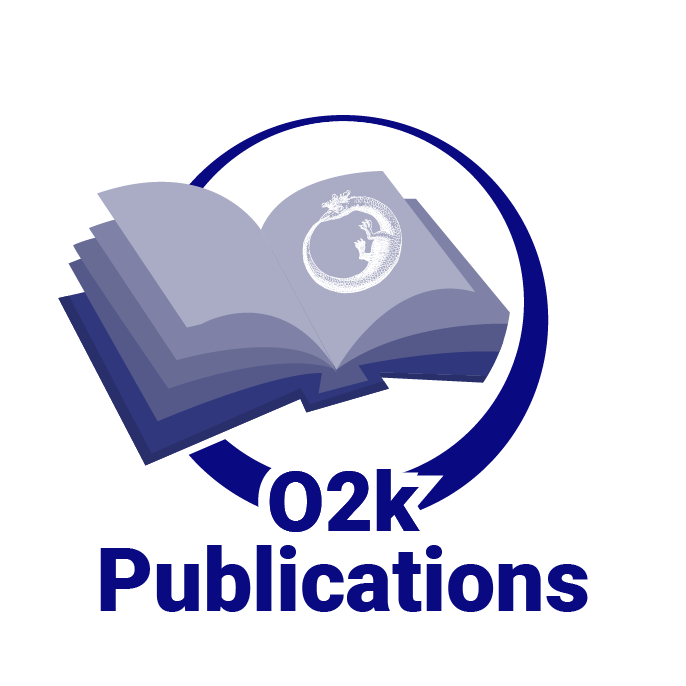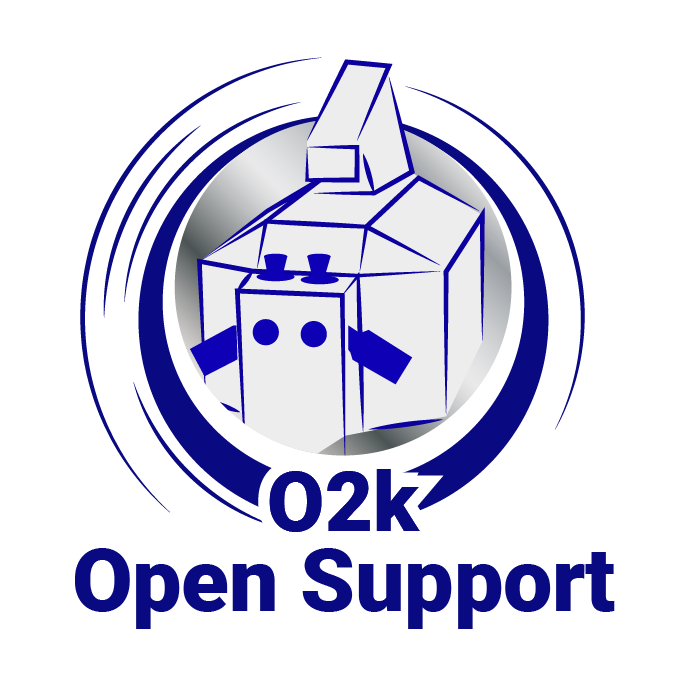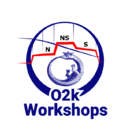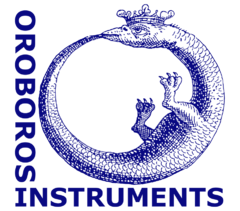From Bioblast
Oroboros
| Name | Oroboros O2k-Team, |
|---|---|
| Institution |
Oroboros Instruments GmbH High-resolution respirometry |
| Address | Schöpfstrasse 18, 6020 |
| City | Innsbruck |
| State/Province | |
| Country | Austria |
| [email protected] | |
| Weblink | Oroboros Instruments, https://www.oroboros.at/ |
| O2k-Network Lab | AT Innsbruck Oroboros |
Labels:
Field of research: Basic, Diagnostic
Topics: high-resolution respirometry
Publications
| Published | Reference | |
|---|---|---|
| MiPNet28.12 IOC167 Schroecken AT | 2024-09-30 | Schroecken AT, 2024 Sep 30 - Oct 05. Oroboros O2k-Workshop on high-resolution respirometry (HRR), IOC167. |
| IOC166 Ljubljana SI | 2024-09-26 | Ljubljana SI, 2024 Sep 26. Satellite symposium and workshop "Skeletal Muscle Research – from Cell to Human", IOC166. |
| IOC165 Wuerzburg DE | 2024-09-14 | Wuerzburg DE, 2024 Sep ## - Sep ##. MetaHEART Workshop, IOC165. |
| MiPNet28.13 IOC164 Innsbruck AT | 2024-09-02 | Innsbruck AT, 2024 Sep 02-04. EBEC2024 Satellite Oroboros O2k-Workshop: Mito&Chlora High-Resolution Respirometry and PhotoBiology, IOC164. |
| MiPNet28.11 IOC163 Schroecken AT | 2024-06-17 | Schroecken AT, 2024 Jun 17-22. Oroboros O2k-Workshop on high-resolution respirometry (HRR), IOC163. |
| Long Night of Research 2024 Innsbruck AT | 2024-05-24 | Innsbruck, AT, 2024 May 24. Oroboros at Long Night of Research. |
| MiPNet18.10 O2k-Specifications | 2024-03-26 | O2k-specifications for respirometry and comprehensive OXPHOS analysis. |
| MiPNet28.08 Oroboros O2k Series J manual | 2023-10-19 | Oroboros O2k Series J manual |
| MiPNet14.06 Instrumental O2 background | 2023-10-19 | O2k Quality Control 2: Instrumental oxygen background correction and accuracy of oxygen flux. |
| MiPNet28.07 NextGen-O2k Series XB manual | 2023-10-19 | NextGen-O2k Series XB manual |
| 2nd Workshop on Mitochondrial Functional Diagnostics Innsbruck AT | 2023-10-16 | Innsbruck AT, 2023 Oct 16. 2nd Workshop on Mitochondrial Functional Diagnostics |
| MiPNet28.02 IOC162 Schroecken AT | 2023-10-02 | Schroecken AT, 2023 Oct 02-07. Oroboros O2k-Workshop on high-resolution respirometry (HRR), IOC162. |
| MiPNet28.10 SmartPOS-service | 2023-09-29 | SmartPOS: Service |
| MiPNet19.14 SOP Hamilton microsyringes | 2023-09-28 | SOP for manual O2k-titrations with Hamilton microsyringes. |
| MiPNet28.09 O2k-Fluo Smart-Module manual | 2023-09-25 | O2k-Fluo Smart-Module manual |
| 1st Workshop on Mitochondrial Functional Diagnostics Innsbruck AT | 2023-07-10 | Innsbruck AT, 2023 Jul 10. 1st Workshop on Mitochondrial Functional Diagnostics |
| MiPNet28.01 IOC160 Schroecken AT | 2023-06-19 | Schroecken AT, 2023 Jun 19-24. Oroboros O2k-Workshop on high-resolution respirometry (HRR), IOC160. |
| DORA and Bioenergetics Communications | 2023-05-16 | Innsbruck, AT, 2023 May 16. DORA and Bioenergetics Communications |
| Oroboros distributor training 2023 Innsbruck AT | 2023-04-24 | Innsbruck AT, 2023 Apr 24-25 Oroboros distributor training. |
| 2nd Oroboros distributor training 2023 Innsbruck AT | 2023-04-24 | Innsbruck AT, 2023 Nov 07-09 2nd Oroboros distributor training. |
| MiPNet28.06 IOC161 Coimbra PT | 2023-04-12 | Cantanhede, PT, 2023 Apr 12. Oroboros O2k-Workshop on high-resolution respirometry (HRR), IOC161. |
| MiPNet22.11 O2k-FluoRespirometer manual | 2023-03-14 | O2k-FluoRespirometer manual. |
| MiPNet19.03 O2k-cleaning and ISS | 2023-03-14 | O2k-Chamber cleaning SOP and Integrated Suction System (ISS). |
| MiPNet28.05 IOC158 Innsbruck AT | 2023-02-27 | Innsbruck AT, 2023 Feb 27 - Mar 01. O2k-Coaching Days - Basic, IOC158. |
| MiPNet28.03 IOC157 Los Angeles US | 2023-02-14 | Los Angeles, CA US, 2023 Feb 14-16. Oroboros O2k-Workshop on high-resolution respirometry (HRR), IOC157. |
| MiPNet06.03 POS-calibration-SOP | 2023-02-06 | O2k Quality Control 1: Polarographic oxygen sensors and accuracy of calibration. |
| MiPNet25.16 Virtual O2k-Workshop HRR | 2023 | Virtual O2k-Workshop on high-resolution respirometry (HRR) - Basic and Advanced (O2 and H2O2 fluxes) |
| MiPNet26.07 Installation and startup support session | 2023 | Virtual Oroboros Installation and startup support session |
| Virtual OroDM02 | 2023 | Virtual Oroboros Distributor Meeting, OroDM02 |
| MiPNet27.10 IOC156 Ramat Gan IL | 2022-11-28 | Ramat Gan IL, 2022 Nov 28-30 Oroboros O2k-Workshop on high-resolution respirometry (HRR), IOC156. |
| MiPNet26.14 Oxia | 2022-10-31 | Oxia - HyperOxia to HypOxia. |
| MiPNet27.04 IOC155 Schroecken AT | 2022-10-03 | Schroecken AT, 2022 Oct 03-08. Oroboros O2k-Workshop on high-resolution respirometry (HRR), IOC155. |
| MiPNet27.05 Schroecken BEC tutorial-Living Communications pmP | 2022-09-30 | Schroecken AT, 2022 Sep 30-Oct 03. BEC tutorial-Living Communications: pmF to pmP — pre IOC155. |
| MiPNet27.07 Sample Holder | 2022-08-09 | Sample Holder. |
| MiPNet27.03 IOC154 Innsbruck AT | 2022-08-01 | Innsbruck AT, 2022 Aug 01-05. O2k-Coaching Days - O2k-FluoRespirometer and NextGen-O2k, IOC154. |
| MiPNet26.13 NextGen-O2k manual | 2022-07-25 | NextGen-O2k manual |
| MiPNet27.02 IOC153 Innsbruck AT | 2022-07-01 | Innsbruck AT, 2022 Jul 01-02. NextGen-O2k All-in-one Demo Workshop IOC153. |
| Bioblast 2022 | 2022-06-29 | |
| Long Night of Research 2022 Innsbruck AT | 2022-05-20 | Innsbruck, AT, 2022 May 20. Oroboros at Long Night of Research, CCB. The diagnostic bioenergetic report – a milestone on the way to mitochondrial fitness and physical well-being. |
| MiPNet26.12 NextGen-O2k: NADH-Module | 2022-05-17 | NextGen-O2k: NADH-Module manual |
| MiPNet27.01 IOC152 Hamburg DE | 2022-05-14 | Hamburg DE, 2022 May 14. Oroboros O2k-Lunch Workshop: Continuous monitoring of mitochondrial Coenzyme Q redox state integrated in high-resolution respirometry, IOC152 at 10th Conference of the International Coenzyme Q10 Association 2022 Hamburg DE. |
| MiPNet11.05 imt-pti-pce | 2022-04-10 | Isolated mitochondria or permeabilized tissues and cells. |
| MiPNet22.10 MiR05-Kit | 2022-03-03 | Mitochondrial Respiration Medium - MiR05-Kit. |
| MiPNet08.16 pH calibration | 2022-03-01 | Laboratory protocol: pH measurement and temperature dependence of pH. |
| MiPNet24.12 NextGen-O2k: Q-Module | 2021-10-29 | NextGen-O2k: Q-Module manual |
| MiPNet26.11 NextGen-O2k: PB-Module | 2021-10-29 | NextGen-O2k: PB-Module manual |
| MiPNet24.16 DatLab8.0: CV-Module | 2021-10-28 | DatLab8.0: Cyclic voltammetry manual |
| MiPNet24.10 H2O2 flux analysis | 2021-10-22 | Hydrogen peroxide flux analysis using Amplex UltraRed assay in MiR05-Kit with DatLab 7.4 |
| MiPNet 26.16 NextGen-O2k Summit 2021 Virtual | 2021-10-20 | Virtual, 2021 Oct 20. NextGen-O2k Summit, NextGen-O2k SME2. MiPNet 26.16. |
| MiPNet24.09 Data analysis of mt-membrane potential | 2021-09-16 | Data analysis of mt-membrane potential. |
| MiPNet26.10 MgG data analysis | 2021-09-16 | Measurement of mitochondrial ATP production using Magnesium Green: DL-Protocols and data analysis with DatLab 7.4 |
| MiPNet20.06 IsolationMouseHeart-mt | 2021-08-09 | Laboratory protocol: isolation of mouse heart mitochondria. |
| MiPNet15.03 O2k-MultiSensor-ISE | 2021-08-02 | O2k-MultiSensor system with ion selective electrodes (ISE). |
| MiPNet 26.15 NextGen-O2k Event Photobiology: Algal bioenergetics Innsbruck AT | 2021-07-15 | Innsbruck AT, 2021 Jul 15-16. NextGen-O2k Event Photobiology: Algal bioenergetics. MiPNet 26.15. |
| MiPNet12.10 TIP2k-manual | 2021-07-08 | Titration-Injection microPump TIP2k manual. |
| MiPNet19.18B POS-service | 2021-06-23 | Service of the polarographic oxygen sensor OroboPOS. |
| MiPNet17.05 O2k-Fluo LED2-Module | 2021-06-22 | O2k-Fluo LED2-Module. |
| MiPNet26.06 DatLab 7: Guide | 2021-06-02 | DatLab-guide through the menus. |
| MiPNet20.04 O2k-checklist | 2021-03-12 | O2k-checklist: get started with an O2k-experiment. |
| MiPNet26.02 Virtual O2k-Workshop:Q-Module | 2021-02-02 | Virtual O2k-Workshop on high-resolution respirometry (HRR) - Basic O2k and NextGen-O2k, Q-Module (for Key opinion leaders) |
| MiPNet25.17 Virtual O2k-Workshop PhotoBiology | 2021 | Virtual O2k-Workshop on high-resolution respirometry (HRR) - Basic O2k and NextGen-O2k, PhotoBiology Module (for Key opinion leaders) |
| MiPNet25.04 IOC146 Padua IT | 2020-11-20 | Virtual, 2020 Nov 20. O2k-Introduction: Commitment to reproducibility in targeting mitochondrial respiratory control IOC146. |
| MiPNet21.17 BloodCellsIsolation | 2020-10-22 | O2k-Protocols: Isolation of blood cells for HRR. |
| Long Night of Research 2020 Virtual Event | 2020-10-09 | Virtual Event, 2020 Oct 09. Oroboros at Long Night of Research, CCB. The diagnostic bioenergetic report – a milestone on the way to mitochondrial fitness and physical well-being. |
| MiPNet09.12 O2k-Titrations | 2020-08-17 | O2k manual titrations: SUIT protocols with mitochondrial preparations. |
| MiPNet24.08 Safranin Analysis Template | 2020-05-13 | Excel template for safranin data analysis. |
| MiPNet17.04 CitrateSynthase | 2020-04-18 | Laboratory protocol: Citrate synthase a mitochondrial marker enzyme. |
| MiPNet24.06 Oxygen flux analysis - DatLab 7.4 | 2020-04-16 | Oxygen flux analysis with DatLab 7.4. |
| MiPNet24.14 O2k-sV-Module manual | 2020-03-17 | O2k-sV-Module manual. |
| MiPNet25.10 Distributor engagement Tokyo JP | 2020-02-04 | Tokyo,JP, 2020 Feb 4-7. On-site O2k-Workshop on High-Resolution Respirometry and partner distribution engagement. |
| MiPNet25.08 O2k-IQOQ protocol | 2020-02-04 | O2k-Installation Qualification (IQ)/ Operational Qualification (OQ) protocol |
| MiPNet25.06 IOC145 Innsbruck AT | 2020-01-27 | Innsbruck AT, 2020 Jan 27-29. O2k-Coaching Days - Basic IOC145. |
| MiPNet25.03 IOC144 Innsbruck AT | 2020-01-20 | Innsbruck AT, 2020 Jan 20-22. O2k-Coaching Days - Basic IOC144. |
| MiPNet25.14 TPP Analysis Template | 2020-##-## | Excel template for TPP data analysis. |
| Residual oxygen consumption | 2020 | Gnaiger E (2020) Residual oxygen consumption: a baseline correction of mitochondrial respiration. Mitochondr Physiol Network (2016-01-28) last update 2020-11-11. |
| P/E control ratio | 2020 | Gnaiger E (2020) P/E from mouse to man. Mitochondr Physiol Network (2014-05-20) last update 2020-11-12. |
| P-L control efficiency | 2020 | Gnaiger E (2020) Cell ergometry: OXPHOS-control and ET-coupling efficiency. Mitochondr Physiol Network (2015-01-18) last update 2020-11-12. |
| E-L coupling efficiency | 2020 | Gnaiger E (2020) Biochemical coupling efficiency: from 0 to <1. Mitochondr Physiol Network (2015-01-18) last update 2020-11-12. |
| Flux control efficiency | 2020 | Gnaiger E (2020) Flux control efficiency: normalization of mitochondrial respiration. Mitochondr Physiol Network 2016-03-20; updated 2020-11-10. |
| MiPNet25.02 IOC Schroecken AT | 2020 | Schroecken AT, Oroboros O2k-Workshop on high-resolution respirometry (HRR), IOC. - Due to COVID-19 we change the strategy and provide the O2k-Workshop in a virtual form. |
| Electron transfer pathway | 2020 | Gnaiger E (2017) Electron transfer pathway versus electron transport chain. Mitochondr Physiol Network (2010-08-17) last update 2020-06-02. |
| OXPHOS capacity | 2020 | Gnaiger E (2020) OXPHOS P and State 3. Mitochondr Physiol Network (2016-07-15) last update 2020-11-08. |
| NextGen-O2k SME2 coaching Orily Pratt part 2 | 2019-12-03 | Innsbruck AT, 2019 Dec 03-04 NextGen-O2k SME2 coaching Orily Pratt (part 2), NextGen-O2k SME2. |
| MiPNet14.10 O2k-Top 10 | 2019-11-28 | Oroboros (2019) Top 10 reasons for the Oroboros Ecosystem. Mitochondr Physiol Network 14.10(13):1-4. |
| MiPNet24.15 IOC143 Haryana IN | 2019-11-15 | Haryana IN, 2019 Nov 15. Oroboros O2k-Workshop on high-resolution respirometry: Assessment of mitochondrial function in health and disease IOC143. |
| MiPNet24.13 IOC142 Fukuoka JP | 2019-10-03 | ASMRM & J-mit 2019, Fukuoka JP, 2019 Oct 03 Oroboros Lunch Seminar at ASMRM & J-mit 2019 Fukuoka JP - Explore the Mito-World! (IOC142). |
| MiPNet21.16 DatLab 7 Innovations | 2019-09-23 | DatLab 7: innovations. |
| MiPNet24.02 IOC141 Schroecken AT | 2019-09-23 | Schroecken AT, 2019 Sep 23-28 Oroboros O2k-Workshop on high-resolution respirometry (HRR), IOC141. |
| MiPNet23.12 DL-Protocols help | 2019-09-13 | DatLab Protocols: Help DatLab 7. |
| MiPNet22.16 DatLab 7 Innovations: DL-Protocols | 2019-09-13 | DatLab 7.4 Innovations: DL-Protocols |
| NextGen-O2k SME2 coaching Samia Kappe part 1 | 2019-09-12 | Innsbruck AT, 2019 Sep 10-11 NextGen-O2k SME2 coaching Samia Kappe (part 1), NextGen-O2k SME2. |
| MiPNet24.11 mtMP calculation | 2019-08-05 | Mitochondrial membrane potential calculation |
| NextGen-O2k SME2 coaching Orily Pratt part 1 | 2019-07-22 | Innsbruck AT, 2019 Jul 22-23 NextGen-O2k SME2 coaching Orily Pratt (part 1), NextGen-O2k SME2. |
| OroDM01 Innsbruck AT | 2019-07-01 | Innsbruck AT, 2019 Jul 01-03 Oroboros Distributor Meeting, OroDM01. |
| MiPNet20.13 Safranin mt-membranepotential | 2019-06-24 | O2k-FluoRespirometry: HRR and simultaneous determination of mt-membrane potential with safranin or TMRM. |
| MiPNet18.05 Amplex-Mouse-heart | 2019-06-24 | O2k-Fluorometry: HRR and H2O2 production in mouse cardiac tissue homogenate. |
| MiPNet20.14 AmplexRed H2O2-production | 2019-06-24 | O2k-FluoRespirometry: HRR and simultaneous determination of H2O2 production with Amplex UltraRed. |
| MiPNet18.06 Amplex-Yeast | 2019-06-24 | O2k-FluoRespirometry: Amplex UltraRed using freeze-dried baker’s yeast. » Update: Komlódi T, Sobotka O, Gnaiger E (2021) Facts and artefacts on the oxygen dependence of hydrogen peroxide production using Amplex UltraRed. MitoFit Preprints 2021.10. doi:10.26124/mitofit:2021-0010 |
| MiPNet24.04 IOC140 Amsterdam NL | 2019-06-23 | Amsterdam NL, 2019 Jun 23 Pre-conference Oroboros O2k-Workshop on high-resolution respirometry (HRR), IOC140. |
| MiPNet24.01 IOC139 Schroecken AT | 2019-06-17 | Schroecken AT, 2019 June 17-22 Oroboros O2k-Workshop on high-resolution respirometry (HRR), IOC139. |
| MiPNet24.03 IOC138 Xiamen CN | 2019-04-12 | Xiamen CN, 2019 Apr 12. Post-conference Oroboros O2k-Workshop on high-resolution respirometry (HRR), IOC138. |
| MiPNet12.23 FiberRespiration | 2019-01-10 | Mitochondrial respiration in permeabilized fibers: Needle biopsies from horse skeletal muscle. |
| LEAK respiration | 2019 | Gnaiger E (2019) LEAK respiration: concept-linked terminology of respiratory states. Mitochondr Physiol Network 2019-01-24. |
| Electron-transfer-pathway state | 2019 | Gnaiger E (2019) ET-pathway states. Mitochondr Physiol Network 2019-06-11 (last edit since 2016-11-08). |
| MiPNet07.07 O2k-NetworkInvitation | 2019 | Oroboros (2019) Invitation to join the O2k-Network as a reference laboratory for high-resolution respirometry. Mitochondr Physiol Network 07.07: 1. |
| MiPNet23.11 IOC137 Innsbruck AT | 2018-12-10 | Innsbruck AT, 2018 Dec 10-12. MitoFit Coaching Days - Basic IOC137. |
| MiPNet23.09 IOC136 Melbourne AU | 2018-11-27 | Melbourne AU, 2018 Nov 27-28 Oroboros O2k-Workshop on high-resolution respirometry (HRR), IOC136. |
| MiPNet12.01 Suppl T-issue | 2018-11-18 | MitoPathways at the Q-junction: mouse skeletal muscle fibers. |
| MiPNet23.14 IOC135 Busan KR | 2018-11-06 | ASMRM 2018, Busan KR, 2018 Nov 06 to 07. Oroboros for MIRACLE - the bioenergetic snapshot of mitochondrial fitness (IOC135). |
| MiPNet23.08 IOC134 Schroecken AT | 2018-10-01 | Schroecken AT, 2018 Oct 01-06 Oroboros O2k-Workshop on high-resolution respirometry (HRR), IOC. |
| MiPNet23.15 O2k-pH ISE-Module | 2018-09-08 | Measurement of proton flux with the O2k-pH ISE-Module. |
| MiPNet23.04 IOC133 Innsbruck AT | 2018-09-05 | Innsbruck AT, 2018 Sep 05-07. MitoFit Coaching Days - Basic IOC 133. |
| MiPNet23.07 IOC132 Budapest HU | 2018-08-24 | Budapest HU, 2018 Aug 24-25 Oroboros satellite O2k-Workshop on high-resolution respirometry (HRR), IOC. |
| MiPNet23.13 IOC131 Kuala Lumpur MY | 2018-07-17 | Kuala Lumpur MY, 2018 Jul 17 Oroboros satellite O2k-Workshop on high-resolution respirometry (HRR), IOC131. |
| MiPNet21.06 SUIT RP | 2018-06-25 | SUIT reference protocol for OXPHOS analysis by high-resolution respirometry. |
| MiPNet23.06 IOC130 Schroecken AT | 2018-06-18 | Schroecken AT, 2018 Jun 18-23 Oroboros O2k-Workshop on high-resolution respirometry (HRR), IOC130. |
| MiPNet23.10 IOC129 Lausanne CH | 2018-06-04 | Lausanne CH, 2018 Jun 04-05 Oroboros O2k-Workshop on high-resolution respirometry (HRR), IOC129. |
| MiPNet23.03 IOC128 Cambridge UK | 2018-05-07 | Cambridge UK, 2018 May 7-8. Oroboros satellite O2k-Workshop on high-resolution respirometry IOC128. |
| Long Night of Research 2018 Innsbruck AT | 2018-04-13 | Innsbruck AT, 2018 Apr 13. Oroboros at Long Night of Research, CCB. The diagnostic bioenergetic report – a milestone on the way to mitochondrial fitness and physical well-being. |
| MiPNet23.02 IOC127 Szeged HU | 2018-03-27 | Szeged HU, 2018 Mar 27. Oroboros satellite O2k-Workshop on hypoxia IOC127. |
| MiPNet23.01 IOC126 Innsbruck AT | 2018-01-24 | Innsbruck AT, 2018 Jan 24-26. Oroboros advanced O2k-Workshop on mt-membrane potential: TPP+ and fluorescent dyes. IOC126. |
| MitoFit Workshop ATP 2017 Innsbruck AT | 2017-12-18 | Innsbruck AT, 2017 Dec 18-20. MitoFit Workshop on adenosine triphosphate (ATP). |
| MiPNet22.15 IOC125 Prague CZ | 2017-11-20 | Prague CZ, 2017 Nov 20. Oroboros O2k-Workshop on DatLab7 IOC125. O2k-Network Lab »CZ Prague Houstek J |
| MiPNet07.08 User information | 2017-11-03 | O2k-Manual: user information. PLEASE STUDY THIS MANUAL. |
| MitoFit Open Seminar 2017-10-23 | 2017-10-23 | Innsbruck AT, 2017 Oct 23. Daniel-Swarovski-Research Laboratory Research Seminar WS 2017/2018 - MitoFit Open Seminar on Respiration, cryopreservation and viability test in human blood cells: peripheral blood mononuclear cells (PBMC) and platelets. |
| MiPNet22.07 IOC124 Schroecken AT | 2017-10-03 | Schroecken AT, 2017 Oct 03-08 Oroboros O2k-Workshop on high-resolution respirometry (HRR), IOC124. |
| MiPNet17.09 IOC Questions | 2017-10-02 | IOC-Questions. Mitochondr Physiol Network 17.09(04):1-2. |
| MiPNet22.08 IOC123 Xian CN | 2017-09-11 | Xian CN, 2017 Sep 11 Oroboros O2k-Workshop on high-resolution respirometry (HRR), IOC123. |
| MitoFit Open Seminar 2017-07-14 | 2017-07-14 |
Innsbruck AT, 2017 Jul 14. MitoFit Open Seminar on immune cell bioenergetics. Investigating the role of mitochondria in healthy and psychopathological aging. |
| MiPNet22.06 IOC121 Cologne DE | 2017-06-12 | Cologne DE, 2017 Jun 12. Oroboros O2k-Lunch Workshop on high-resolution respirometry (HRR), IOC121 at EUROMIT2017 Cologne DE. |
| MiPNet22.05 National O2k-Workshop Shanghai CN | 2017-05-13 | Shanghai CN, 2017 May 13-14. National O2k-Workshop on high-resolution respirometry (HRR) by the Oroboros representative in China |
| MiPNet22.04 IOC120 Barcelona ES | 2017-03-20 | Barcelona ES, 2017 Mar 20. O2k-Workshop on high-resolution respirometry (HRR) IOC120. »ES Barcelona Zorzano A |
| MiPNet22.03 IOC119 Innsbruck AT | 2017-02-27 | Innsbruck AT, 2017 Feb 28-Mar 03. MitoFit Coaching Days - Basic IOC119. |
| MiPNet22.02 IOC118 Hyderabad IN | 2017-02-07 | Hyderabad IN, 2017 Feb 07-08 Oroboros Pre-conference O2k-Workshop on high-resolution respirometry (HRR), IOC118. »IN Hyderabad Thangaraj K. |
| MiPNet15.09. Yeast: HRR Reference Assay | 2017-02-05 | A mitochondrial reference assay for high-resolution respirometry using freeze-dried Baker’s yeast. |
| ET capacity | 2017 | Gnaiger E (2017) Why ET capacity, why not State 3u? Mitochondr Physiol Network (2014-07-06) last update 2020-11-10. |
| Categories of SUIT protocols | 2017 | Gnaiger E (2017) Categories of SUIT protocols and ETS pathway control states. MiPNet 2017-03-12; original 2016-03-20; edited 2016-08-21. |
| MiPNet21.19 IOC114 Innsbruck AT | 2016-12-12 | Innsbruck AT, 2016 Dec 12-15. MitoFit Coaching Days - Basic IOC114. |
| MiPNet21.11 IOC116 Innsbruck AT | 2016-11-21 | Innsbruck AT, 2016 Nov 21-25. Oroboros O2k-Workshop on O2k-Fluorometry - advanced, IOC116. |
| MiPNet20.08 IsolationRatLiver-mt | 2016-11-18 | Laboratory Protocol: isolation of rat liver mitochondria. |
| MiPNet21.14 Reference sample HRR | 2016-10-19 | Development of a reference sample for HRR. |
| MiPNet21.12 Comparison mt respiration media | 2016-10-18 | O2k-MultiSensor: Mitochondrial respiration media for HRR and simultaneous O2k-Fluorometry. |
| MiPNet21.13 Comparison mt-preparations | 2016-10-18 | O2k-Protocols: Mitochondrial preparations for HRR. |
| MiPNet21.10 IOC115 Schroecken AT | 2016-10-03 | Schroecken AT, 2016 Oct 03-08. Oroboros O2k-Workshop on high-resolution respirometry (HRR) and O2k-Fluorometry, IOC115. |
| MiPNet21.18 IOC117 Kuala Lumpur MY | 2016-09-26 | Kuala Lumpur MY, 2016 Sep 26-30. Oroboros O2k-Workshop on high-resolution respirometry (HRR) and O2k-Fluorometry, IOC117. |
| MiPNet14.13 Medium-MiR06 | 2016-08-30 | Mitochondrial respiration medium - MiR06. |
| MiPNet03.02 Chemicals-Media | 2016-08-30 | Selected media and chemicals for respirometry with mitochondrial preparations. |
| MiPNet19.18D O2k-Series G and DatLab 6: Calibration | 2016-08-24 | O2k-calibration by DatLab 6. |
| MiPNet19.18C DatLab 6: Guide | 2016-08-24 | DatLab-guide through the menus. |
| MiPNet08.09 CellRespiration | 2016-08-11 | High-resolution respirometry and coupling-control protocol with living cells: ROUTINE, LEAK, ET-pathway, ROX. |
| MiPNet19.18A O2k-Series G: Start | 2016-08-08 | Oxygraph-2k: start high-resolution respirometry. |
| MiPNet21.09 IOC113 Havana CU | 2016-08-08 | Havana CU, 2016 Aug 08-09. Oroboros O2k-Workshop on high-resolution respirometry (HRR) and O2k-Fluorometry, IOC113. O2k-Network Lab » CU Havana Pardo Andreu GL |
| MiPNet10.04 CellRespiration | 2016-08-08 | An experiment with high-resolution respirometry: coupling control in cell respiration. |
| MiPNet19.18 O2k-Series G Core manual | 2016-08-08 | O2k-Core manual contents. |
| MiPNet19.18E O2 flux analysis - DatLab 6 | 2016-08-08 | Oxygen flux analysis: DatLab real-time. |
| MiPNet21.07 MitoFit DatLab PT | 2016-07-20 | MitoFit DatLab proficiency test. |
| MitoFit Science Camp 2016 Kuehtai AT | 2016-07-07 | Kuehtai AT, 2016 Jul 07-13. MitoFit Science Camp and IOC112. |
| MiPNet21.15 IOC112 Kuehtai AT | 2016-07-07 | Kuehtai AT, 2016 Jul 07-13. MitoFit Science Camp and IOC112. |
| MiPNet20.07 IsolationRatBrain-mt | 2016-06-18 | Laboratory Protocol: isolation of rat brain mitochondria. |
| MiPNet21.02 IOC111 Seattle WA US | 2016-06-13 | Seattle WA US, 2016 Jun 13-14. Oroboros O2k-Workshop on high-resolution respirometry (HRR) and O2k-Fluorometry, IOC111. O2k-Network Lab »US WA Seattle Marcinek DJ |
| Long Night of Research 2016 Innsbruck AT | 2016-04-22 | Innsbruck AT, 2016 Apr 22. OROBOROS at Long Night of Research, CCB. MitoFit – Training for the powerhouses of your blood- and muscle cells. |
| MiPNet15.05 NO-manual | 2016-04-21 | O2k-MultiSensor system with amperometric sensors: NO, H2S, H2O2. |
| MiPNet21.04 IOC110 Melbourne AU | 2016-04-12 | Melbourne AU, 2016 Apr 12-13. Oroboros O2k-Workshop on high-resolution respirometry (HRR) and O2k-Fluorometry, IOC110. O2k-Network Lab »AU Melbourne Stepto NK |
| MiPNet21.01 IOC109 Schroecken AT | 2016-04-03 | Schroecken AT, 2016 Apr 03-08. OroborosO2k-Workshop on high-resolution respirometry (HRR) and O2k-Fluorometry, IOC109. |
| MiPNet14.05 TPP-mtMembranePotential | 2016-04-01 | TPP+ and mt-membrane potential. |
| MiPNet20.15 IsolationRatHeart-mt | 2016-03-25 | Laboratory protocol: isolation of rat heart mitochondria. |
| MiPNet21.05 IOC108 Singapore SG | 2016-03-06 | Singapore SG, 2016 Mar 06-07. Oroboros O2k-Workshop on high-resolution respirometry (HRR) and O2k-Fluorometry, IOC108. |
| MiPNet21.08 IOC107 Vienna AT | 2016-02-16 | Vienna AT, 2016 Feb 16. Oroboros O2k-Workshop on high-resolution respirometry (HRR) and O2k-Fluorometry, IOC107. |
| MitoFit Workshop en.co.tec medical device 2016-02-04 | 2016-02-04 | Innsbruck AT, 2016 Feb 04. MitoFit Workshop en.co.tec medical device. |
| MitoFit Workshop Blood Cells 2016-01-08 | 2016-01-08 | Innsbruck AT, 2016 Jan 08. MitoFit Workshop on blood cell respirometry for mitochondrial research and diagnostic applications. |
| MiPNet20.10 IOC106 Schroecken | 2015-10-06 | Schroecken AT, 2015 Oct 06-11. Oroboros O2k-Workshop on HRR and O2k-Fluorometry, IOC106. |
| MiPNet20.16 IOC105 Riga | 2015-08-27 | Riga LV, 2015 Aug 27. Oroboros O2k-Workshop on high-resolution respirometry (HRR) and O2k-Fluorometry - innovabalt, IOC105. |
| MiPNet20.05 IOC104 Greenville | 2015-08-09 | Greenville NC US, 2015 Aug 09-10. Oroboros O2k-Workshop on HRR and O2k-Fluorometry, IOC104. |
| MiPNet20.12 IOC103 Manaus | 2015-07-06 | Manaus BR, 2015 Jul 06-10. To the heart of the Amazon. O2k-Workshop on HRR and O2k-Fluorometry, IOC103. |
| Qualitätszirkel 2015 | 2015-06-30 | Innsbruck AT, 2015 Jun 30. Qualitätszirkel Programm pdf |
| MiPNet14.14 PermeabilizedFiberPreparation | 2015-06-22 | Preparation of permeabilized muscle fibers for diagnosis of mitochondrial respiratory function. |
| MiPNet17.15 PBI-Shredder Mouse-heart-brain-liver | 2015-06-22 | Tissue homogenates for diagnosis of mitochondrial respiratory function: Mouse heart, brain and liver. |
| MiPNet17.02 PBI-Shredder manual | 2015-06-19 | PBI-Shredder HRR-Set: preparation of tissue homogenates for diagnosis of mitochondrial respiratory function. |
| MiPNet17.03 Shredder vs Fibers | 2015-06-18 | Mitochondrial respiration in permeabilized fibers versus homogenate from fish liver and heart. An application study with the PBI-Shredder. |
| MiPNet17.16 O2k-Spectrophotometry | 2015-06-16 | O2k-Spectrophotometry - A MitoCom Project. |
| MiPNet20.09 IsolationBeefHeart-mt | 2015-06-15 | Laboratory protocol: isolation of beef heart mitochondria. |
| MiPNet19.17 O2k Series G | 2015-06-15 | O2k Series G: innovations |
| MiPNet19.19 DatLab 6 | 2015-06-15 | DatLab 6: innovations. |
| MiPNet20.11 IOC102 Wuhan CN | 2015-05-25 | Wuhan CN, 2015 May 25-26. Oroboros O2k-Workshop on HRR and O2k-Fluorometry, IOC102. Oroboros representative in China: »:CN Shanghai Zenda. |
| MiPNet06.06 Chemical O2 background | 2015-04-27 | Oxygraph assay of cytochrome c oxidase activity: chemical background correction. |
| MiPNet20.03 IOC101 London | 2015-04-21 | London UK, 2015 Apr 21-23. Oroboros O2k-Workshop on HRR and O2k-Fluorometry, IOC101. |
| MiPNet20.01 IOC100 Schroecken | 2015-04-09 | Schroecken AT, 2015 Apr 09-14. Oroboros O2k-Workshop on HRR, O2k-Fluorometry and TPP, IOC100. |
| MiPNet20.02 IOC99 Cape Town | 2015-03-23 | Cape Town ZA, 2015 Mar 23-24. Oroboros O2k-Workshop on HRR and O2k-Fluorometry, IOC99. - Satellite to 7th MiPschool Cape Town 2015. |
| Coupling-control protocol | 2015 | Gnaiger E (2015) From PCP to CCP. Mitochondr Physiol Network 2015-01-11. |
| MiPNet09.01 O2k-ParadigmShift | 2015 | Oxygraph-2k: Paradigm shift and features of high-resolution respirometry. Mitochondr Physiol Network 09.01. |
| Cell ergometry | 2015 | Gnaiger E (2015) Cell ergometry and OXPHOS. Mitochondr Physiol Network 2015-01-18. |
| MiPNet19.16 IOC98 | 2014-11-17 | Taipei TW, 2014 Nov 17-20. Oroboros O2k-Workshop on HRR and O2k-Fluorometry, IOC98. |
| MiPNet17.17 Amplex-Mouse-brain | 2014-11-14 | O2k-Fluorometry: HRR and H2O2 production in mouse brain mitochondria. |
| MiPNet19.11 IOC96 Schroecken AT | 2014-10-07 | Schroecken AT, 2014 Oct 07-12. Oroboros O2k-Workshop on HRR and O2k-Fluorometry, IOC96. |
| MiPNet19.15 IOC97 | 2014-09-25 | Lausanne CH, 2014 Sep. 25-26 Oroboros O2k-Workshop on HRR and O2k-Fluorometry, IOC97. |
| MiPNet19.10 IOC95 Obergurgl | 2014-09-12 | Obergurgl AT, 2014 Sep 12-16. Oroboros O2k-Workshop on O2k-Fluorometry, IOC95 at MiP2014. |
| EBEC2014 | 2014-07-12 | Lisbon PT, 2014 Jul 12-17. 18th European Bioenergetics Conference - EBEC2014 Harrison DK, Fasching M, Fontana-Ayoub M, Gnaiger E (2014) The relationship between cytochrome redox state and oxygen consumption in isolated mouse and beef heart mitochondria during hypoxia. EBEC2014. Krumschnabel G, Eigentler A, Fasching M, Gnaiger E (2014) Combined high-resolution respirometry and fluorometry. Validation of safranin for determination of mitochondrial membrane potential. EBEC2014. |
| MiPNet19.09 IOC94 Shanghai CN | 2014-06-27 | Shanghai CN, 2014 Jun 27-Jul 02. Oroboros O2k-Workshop on HRR and O2k-Fluorometry, IOC94. Oroboros representative in China: »CN Shanghai Zenda. |
| MiPNet19.08 IOC93 | 2014-06-17 | Tampere FI, 2014 Jun 17. Oroboros O2k-Lunch Workshop on HRR and O2k-Fluorometry, IOC93 at EUROMIT2014. |
| MiPNet19.07 IOC92 | 2014-06-05 | Pittsburgh US, 2014 Jun 04-07. OROBOROS O2k-Lunch Workshop on HRR and O2k-Fluorometry, IOC92 at UMDF2014. |
| MiPNet19.06 IOC91 Philadelphia US | 2014-06-02 | Philadelphia US, 2014 Jun 02-03. Oroboros O2k-Workshop on HRR and O2k-Fluorometry, IOC91. O2k-Network Lab »US PA Philadelphia Wallace DC. |
| MiPNet19.05 IOC90 Bolzano IT | 2014-05-27 | Bolzano IT, 2014 May 27. Applied Workshop - High-resolution respirometry and mitochondrial function under hypoxia: overview, demo experiment and discussion. IOC90 at ISMM2014. |
| MiPNet19.04 IOC89 La Jolla US | 2014-05-01 | La Jolla US, 2014 May 01-02. Oroboros O2k-Workshop on HRR and O2k-Fluorometry, IOC89. O2k-Network Lab »US CA La Jolla Felding-Habermann B |
| MiPNet19.20 Cytochrome c control efficiency | 2014-04-21 | Cytochrome c control efficiency: a test for outer mt-membrane integrity. |
| MiPNet19.02 IOC88 Schroecken AT | 2014-04-07 | Schroecken AT, 2014 Apr 07-12. Oroboros O2k-Workshop on HRR and O2k-Fluorometry, IOC88. |
| Long Night of Research 2014 | 2014-04-04 | Innsbruck AT, 2014 Apr 04. OROBOROS at Long Night of Research and Science, CCB. |
| MiPNet18.16 IOC87 Spitsbergen | 2014-03-24 | Spitsbergen NO, 2014 Mar 24-27. Oroboros O2k-Workshop on HRR and O2k-Fluorometry: Spitsbergen - Enjoy the Cold, IOC87. MiPNet Lab »NO Trondheim Rognmo O. |
| MiPNet19.01A O2k-Start | 2014-03 | O2k: start high-resolution respirometry. |
| MiPNet19.01 O2k-Core Manual Series F DatLab 5 | 2014-03 | O2k-Core Manual - up to O2k-Series F and DatLab 5. |
| MiPNet19.01B POS-Service | 2014-03 | Service of the polarographic oxygen sensor OroboPOS. |
| MiPNet19.01C DatLab Guide | 2014-03 | DatLab guide through the menus. |
| MiPNet19.01E O2 Flux Analysis | 2014-03 | Oxygen flux analysis: DatLab real-time. |
| MiPNet12.11 MitoRespiration | 2014-02-20 | Flux control ratios in isolated mitochondria. OXPHOS capacity and respiratory control. |
| MiPNet18.15 IOC86 | 2014-01-31 | Mumbay IN, 2014 Jan 31. Oroboros O2k-Workshop on HRR and O2k-Fluorometry, IOC86. »IN Mumbai Kolthur-Seetharam U |
| MiPNet18.14 IOC85 | 2014-01-28 | Mahabaleshwar IN, 2014 Jan 28-30. OROBOROS O2k-Workshop on HRR and O2k-Fluorometry, IOC85 at 38th Mahabaleshwar Seminar. MiPNet Lab »IN Mumbai Kolthur-Seetharam U. |
| MiPNet18.13 IOC84 Alaska | 2014-01-04 | Big Lake, Alaska US, 2014 Jan 04-07. Oroboros O2k-Workshop on HRR and Racing dogs at Iditarod, IOC84. »US OK Stillwater Davis MS |
| Noncoupled respiration | 2014 | Gnaiger E (2014) Is respiration uncoupled - noncoupled - dyscoupled? Mitochondr Physiol Network 2014-04-18. |
| Solutions | 2014 | Gnaiger E (2014) Stock-, storage- and working-solutions: How do they differ? Mitochondr Physiol Network 2014-04-17. |
| Respiratory complexes | 2014 | Gnaiger E (2014) Respiratory Complexes - more than five. Mitochondr Physiol Network 2014-07-07. |
| MiPNet19.12 MitoPathways | 2014 | Gnaiger E (2014) Mitochondrial pathways and respiratory control. An introduction to OXPHOS analysis. 4th ed. Mitochondr Physiol Network 19.12. OROBOROS MiPNet Publications, Innsbruck: 80 pp. ISBN 978-3-9502399-8-0. |
| Mitochondrial marker | 2014 | Gnaiger E (2014) Mitochondrial markers and expression of mitochondrial respiration. Mitochondr Physiol Network 2014-07-26. |
| Normothermia | 2014 | Gnaiger E (2014) Normothermia: from endotherms to ectotherms. Mitochondr Physiol Network 2014-04-18. |
| MiPNet19.17 MitoCom2014 | 2014 | MitoCom Tyrol - a success story |
| MiPNet18.17 IOC83 | 2013-12-18 | Bangalore IN, 2013 Dez 18. Oroboros O2k-Workshop on HRR and O2k-Fluorometry, IOC83. |
| MiPNet18.11 IOC82 | 2013-12-10 | Trondheim NO, 2013 Dec 10-11, Oroboros O2k-Workshop on high-resolution respirometry and O2k-Fluorometry, Oroboros IOC82. Satellite to the 5th Seminar on Exercise in Medicine. Trondheim, Norway, O2k-Network Lab »NO Trondheim Rognmo O. |
| MiPNet18.19 IOC81 | 2013-11-05 | Seoul KR, 2013 Nov 05. Oroboros O2k-Workshop on HRR and O2k-Fluorometry, IOC81. |
| MiPNet18.09 IOC80 Schroecken AT | 2013-10-09 | Schroecken AT, 2013 Oct 09-14, Oroboros O2k-Workshop on HRR and O2k-Fluorometry, IOC80 |
| MiPNet18.07 IOC79 | 2013-09-19 | Obergurgl AT, 2013 Sep 19-23, OROBOROS O2k-Workshop on O2k-Fluorometry, IOC79 at MiP2013. |
| MiPNet18.20 IOC78 | 2013-08-27 | Copenhagen DK, 2013 Aug 27-29. Oroboros O2k-Workshop on HRR and O2k-Fluorometry, IOC78. |
| MiPNet18.18 IOC77 | 2013-06-13 | Newport Beach US, 2013 Jun 13. Oroboros O2k-Workshop on HRR and O2k-Fluorometry, IOC77. |
| MiPNet18.04 IOC76 | 2013-05-28 | Prague CZ, 2013 May 28-29. Oroboros O2k-Workshop on high-resolution respirometry (HRR) and O2k-Fluorometry, IOC76. O2k-Network Lab »CZ Prague Kalous M. |
| MiPNet18.03 IOC75 Schroecken AT | 2013-04-09 | Schroecken AT, 2013 Apr 09-14, Oroboros O2k-Workshop on high-resolution respirometry (HRR) and O2k-Fluorometry: O2k-Basic, IOC75. |
| MiPNet18.02 IOC74 | 2013-01-22 | Innsbruck AT, 2013 Jan 22-25,Oroboros O2k-Workshop on high-resolution respirometry (HRR) and TPP/ISE, IOC74. |
| MiPNet18.01 IOC73 | 2013-01-15 | Kolkata IN, 2013 Jan 15-16. O2k-Workshop on high-resolution respirometry, IOC73. O2k-Network Lab »IN Kolkata Chakrabarti S. |
| Basal respiration | 2013 | Gnaiger E (2013) Basal respiration in physiology, cellular bioenergetics and mitochondrial physiology. Mitochondr Physiol Network 2013-07-07. |
| MiPNet17.14 IOC72 Schroecken AT | 2012-12-05 | Schroecken AT, 2012 Dec 05-10. O2k-Workshop on high-resolution respirometry: O2k-Basic, IOC72. |
| MiPNet17.20 IOC71 | 2012-11-07 | Chongqing CN, 2012 Nov 07. Oroboros O2k-Workshop on high-resolution respirometry (HRR) and O2k-Fluorometry, IOC71. |
| MiPNet17.10 IOC70 | 2012-05-29 | Barcelona ES, 2012 May 29-30. Oroboros O2k-Workshop on High-Resolution Respirometry (HRR), IOC70. »ES Barcelona Garcia-Roves PM. |
| MiPNet17.19 IOC69 | 2012-05-07 | Madrid ES, 2012 May 07. Oroboros O2k-Workshop on high-resolution respirometry (HRR) and O2k-Fluorometry, IOC69. |
| MiPNet17.08 IOC68 Schroecken AT | 2012-04-11 | Schroecken AT, 2012 Apr 11-16. Oroboros O2k-Workshop on high-resolution respirometry (HRR), IOC68. |
| MiPNet17.07 IOC67 | 2012-04-02 | Sidney AU, 2012 Apr 02-04. Oroboros O2k-Workshop on high-resolution respirometry, IOC67. »AU Sydney Stocker R. |
| MiPNet17.06 IOC66 | 2012-03-15 | Innsbruck AT, 2012 Mar 15-16. Oroboros O2k-Workshop on high-resolution respirometry (HRR) and O2k-Fluorometry, IOC66. |
| MiPNet17.18 MitoPathways | 2012 | |
| MiPNet17.12 Bioblast 2012 | 2012 | Gnaiger E, Meissner B, Laner V, eds (2012) Bioblast 2012: Mitochondrial Competence. https://bioblast.at/index.php/MiPNet17.12_Bioblast_2012 |
| MiPNet12.17 BovineHeartMito | 2011-12-11 | Mitochondrial respiration with frozen bovine heart mitochondria: diagnostic tests. |
| MiPNet08.12 IOC22 | 2011-12-11 | NO effect on mitochondrial oxygen kinetics at low oxygen. O2k workshop Report. |
| MiPNet15.08 TPP electrode | 2011-12-11 | Ion selective electrode for TPP+ and high-resolution respirometry. |
| MiPNet16.03 IOC65 | 2011-12-10 | Schroecken AT, 2011 Dec 10-15. Oroboros O2k-Workshop on high-resolution respirometry (HRR), IOC65. |
| MiPNet16.02 IOC64 | 2011-12-08 | Hyderabad IN, 2011 Dec 08. Oroboros O2k-Workshop on high-resolution respirometry (HRR) - Satellite to 1st SMRM, IOC64. »IN Hyderabad Thangaraj K. |
| MiPNet16.05 IOC63 | 2011-08-26 | Beijing CN, 2011 Aug 26-27. Oroboros O2k-Workshop on high-resolution respirometry (HRR) and O2k-Fluorometry, IOC63. |
| MiPNet16.04 IOC62 | 2011-07-11 | Innsbruck AT, 2011 Jul 11-13. Oroboros O2k-Workshop on high-resolution respirometry (HRR) and O2k-Fluorometry, IOC62. |
| MiPNet16.01 IOC61 | 2011-04-26 | Schroecken AT, 2011 Apr 26- May 01. Oroboros O2k-Workshop on high-resolution respirometry (HRR), IOC61. |
| IOC62 | 2011 | Innsbruck, AT, 2011 Jul 11-13 Introductory O2k-Workshop - MitoCom Tyrol IOC62. |
| MiPNet15.10 IOC60 | 2010-12-11 | Schroecken AT, 2010 Dec 11-16. Oroboros O2k-Workshop on high-resolution respirometry (HRR), IOC60. |
| MiPNet12.20 O2k-calibration tutorial | 2010-10-19 | O2k: Oxygen calibration and O2k-background tutorial. |
| MiPNet15.07 IOC59 | 2010-10-01 | Obergurgl AT, 2010 Oct 01-06. OROBOROS O2k-Workshop on high-resolution respirometry (HRR), IOC59 at MiP2010. |
| MiPNet15.11 IOC58 | 2010-08-27 | Debrecen HU, 2010 Aug 27- Sep 02. Oroboros O2k-Workshop on high-resolution respirometry (HRR) and O2k-Fluorometry, IOC58. |
| MiPNet08.15 Complex-I | 2010-08-23 | Laboratory protocol: Complex I (NADH:Ubiquinone Oxidoreductase, EC 1.6.5.3). Mitochondrial membrane enzyme. |
| MiPNet08.18 LactateDehydrogenase | 2010-08-06 | Laboratory protocol: Lactate dehydrogenase. Cytosolic marker enzyme. |
| MiPNet08.13 mt-Isolation-RLM | 2010-08-03 | Laboratory protocol: Isolation of rat liver mitochondria. |
| MiPNet15.12 IOC57 Druskininkai LT | 2010-06-10 | Druskininkai LT, 2010 Jun 10- 16. Oroboros O2k-Workshop on high-resolution respirometry (HRR) and O2k-Fluorometry, IOC57. |
| MiPNet15.02 IOC56 | 2010-04-12 | Schroecken AT, 2010 Apr 12-16. 2nd O2k-MultiSensor Workshop, IOC56. |
| MiPNet15.01 IOC55 | 2010-04-07 | Schroecken AT, 2010 Apr 07-12. Oroboros O2k-Workshop on high-resolution respirometry (HRR), IOC55. |
| MiPNet07.01 Advances | 2010 | Oroboros (2010) Advances in high-resolution respirometry. Mitochondr Physiol Network 7.1. |
| MiPNet06.05 Test Experiments on O2k-Specifications | 2010 | Gnaiger E (2010) Test experiments on specifications of the Oroboros Oxygraph. Mitochondr Physiol Network 6.5. |
| MiPNet14.15 IOC54 | 2009-12-11 | Schroecken AT, 2009 Dec 11-16. Oroboros O2k-Workshop on high-resolution respirometry (HRR), IOC54. |
| MiPNet14.11 IOC53 | 2009-07-30 | Schroecken AT, 2009 Jul 30- Aug 04. Oroboros O2k-Workshop on high-resolution respirometry (HRR), IOC53. |
| MiPNet14.08 IOC52 | 2009-06-21 | Baton Rouge US, 2009 Jun 21. Demo O2k-Workshop, IOC52 at MiPsummer 2009. O2k-Network Lab »US LA Baton Rouge Hand SC. |
| MiPNet14.04 IOC51 | 2009-04-22 | Schroecken AT, 2009 Apr 22-26. First Workshop on O2k-MultiSensor, IOC51. |
| MiPNet14.03 IOC50 | 2009-04-18 | Schroecken AT, 2009 Apr 18-22. Oroboros O2k-Workshop on high-resolution respirometry (HRR), IOC50. |
| MiPNet14.02 IOC49 | 2009-02-23 | Gainsville US, 2009 Feb 23-25. Oroboros O2k-Workshop on high-resolution respirometry (HRR), IOC49. »US FL Gainsville Univ Florida. |
| MiPNet14.12 QA-Workshop | 2009 | Quality assurance in respirometric diagnosis of mitochondrial function. MiPNet Workshop 9-10 Dec 2009. Mitochondr Physiol Network 14.12: 1-13. |
| MiPNet14.09 MiP-Collection | 2009 | OROBOROS (2009) Mitochondrial Physiology Collection. Mitochondr Physiol Network 14.09. |
| IOC48 | 2008-11-09 | Tianjin CN, 2008 Nov 09. Workshop at the 5th Meeting of ASMRM Jointly with Chinese Mit'2008 Tianjin University of Sport, IOC48. |
| MiPNet13.04 IOC47 | 2008-07-12 | Schroecken AT, 2008 Jul 12-16. Oroboros O2k-Workshop on high-resolution respirometry (HRR), IOC47. |
| MiPNet13.02 IOC46 | 2008-04-04 | Schroecken AT, 2008 Apr 04-08. Oroboros O2k-Workshop on high-resolution respirometry (HRR), IOC46. |
| MiPNet11.09 MitoPathways-CII | 2007-2011 | Mitochondrial pathways to Complex II, glycerophosphate dehydrogenase and electron transferring flavoprotein. |
| MiPNet12.24 IOC44 | 2007-12-12 | Schroecken AT, 2007 Dec 12-16. Oroboros O2k-Workshop on high-resolution respirometry (HRR), IOC44. |
| IOC43 Montevideo UY 2007 | 2007-10-1 | Montevideo UY, 2007 Sep 01-06. Oroboros O2k-Workshop on high-resolution respirometry (HRR), IOC43. |
| IOC42 | 2007-08-24 | Rio de Janeiro BR, 2007 Aug 24. Oroboros O2k-Workshop on high-resolution respirometry (HRR), IOC42. |
| MiPNet12.19 IOC41 | 2007-07-18 | Schroecken AT, 2007 Jul 18-22. Oroboros O2k-Workshop on high-resolution respirometry (HRR), IOC41. |
| MiPNet12.14 IOC39 | 2007-04-13 | Schroecken AT, 2007 Apr 13-17. Oroboros O2k-Workshop on high-resolution respirometry (HRR), IOC39. |
| MiPNet12.04 IOC38 | 2007-03-03 | Rome IT, 2007 Mar 03. Oroboros O2k-Workshop on high-resolution respirometry (HRR) and mitochondrial physiology. Oroboros IOC38, »IT Rome Sarti P |
| MiPNet12.03 IOC37 | 2007-02-04 | Seoul KR, 2007 Feb 04. Oroboros O2k-Workshop on high-resolution respirometry (HRR) and mitochondrial physiology. Oroboros IOC37. »KR Seoul Lee HK. |
| MiPNet12.16 1st MitoPathways Workshop | 2007 | 1st MitoPathways Workshop. 17-20 April 2007. Mitochondr Physiol Network 12.16: 1-4. |
| MiPNet11.06 IOC36 | 2006-12-13 | Schroecken AT, 2006 Dec 13-17. Oroboros O2k-Workshop on high-resolution respirometry (HRR) and MiPNet workshop, IOC36. |
| MiPNet11.03 IOC35 Schroecken | 2006-08-18 | Schroecken AT, 2006 Aug 18-22. Oroboros O2k-Workshop on high-resolution respirometry (HRR): O2k, TIP-2k and DatLab 4, IOC35. |
| IOC33 | 2006-06-09 | Warsaw PL, 2006 Jun 09-17. FEBS Advanced course - Frontiers in Molecular Biochemistry of Mitochondria, IOC33. |
| MiPNet11.02 IOC32 | 2006-04-21 | Schroecken AT, 2006 Apr 21-25. : Oroboros O2k-Workshop on high-resolution respirometry (HRR): O2k, TIP-2k and DatLab 4, IOC32. |
| MiPNet10.10 O2k-Folder | 2006 | Oroboros O2k (2006) Mitochondr Physiol Network 10.10. |
| MiPNet10.08 IOC31 | 2005-09-13 | Schroecken AT, 2006 Sep 13-16. Oroboros O2k-Workshop on high-resolution respirometry (HRR) and ROS/NO detection, IOC31. |
| MiPNet10.02 IOC30 | 2005-04-08 | Schroecken AT, 2006 Apr 8-10. Oroboros O2k-Workshop on high-resolution respirometry (HRR): O2k, TIP-2k and DatLab 4, IOC30. |
| MiPNet10.09 MiP2005 | 2005 | Gnaiger E, ed (2005) Mitochondrial physiology. The many faces and functions of an organelle. MiP2005 Abstracts. Mitochondr. Physiol. Network 10.09: 1-152. |
| MiPNet09.11 IOC29 | 2004-12-09 | Schroecken AT, 2004 Dec 09-13. Oroboros O2k-Workshop on high-resolution respirometry (HRR), IOC29. |
| MiPNet09.05 IOC28 | 2004-09-15 | Schroecken AT, 2004 Sep 15-21. Oroboros O2k-Workshop on high-resolution respirometry (HRR) and MiPNet meeting, IOC28. |
| MiPNet09.02 IOC27 | 2004-04-14 | Schroecken AT, 2004 Apr 14-18. Oroboros O2k-Workshop on high-resolution respirometry (HRR), IOC27. |
| MiPNet09.14 Monte Rosa Expedition 2004 | 2004 | Monte Rosa Project (2004) Mitochondr Physiol Network 09.14: 1-2. |
| MiPNet08.17 IOC26 | 2003-12-11 | Innsbruck AT, 2003 Dec 11-13. O2k training course on high-resolution respirometry (HRR), IOC26. |
| MiPNet08.11 IOC24 | 2003-09-09 | Schroecken AT, 2003 Sep 09-12. Oroboros O2k-Workshop and training course on high-resolution respirometry (HRR), IOC24. |
| MiPNet08.02 IOC23 | 2003-03-27 | Schroecken AT, 2003 Mar 27-31. Mitochondrial physiology (MiP) workshop on high-resolution respirometry (HRR), IOC23. |
| MiPNet07.05 IOC21 | 2002-06-12 | Innsbruck AT, 2002 Jun 12-15. Oroboros O2k-Workshop on high-resolution respirometry (HRR), IOC21. |
| MiPNet07.02 IOC20 | 2002-02-28 | Bari IT, 2002 Feb 28. Oroboros O2k-Workshop on high-resolution respirometry (HRR), IOC20. |
| MiPNet06.09 IOC19 | 2001-10-04 | Innsbruck AT, 2001 Oct 04-05. Oroboros O2k-Workshop on high-resolution respirometry (HRR), IOC19. |
| MiPNet06.01 O2k-Overview | 2001 | Gnaiger E (2001) The Oxygraph for high-resolution respirometry. Mitochondr Physiol Network 06.01. |
| MiPNet06.08 Weinatmung | 2001 | Oroboros (2001) Weinatmung. Mitochondr Physiol Network 06.08 |
| MiPNet04.05 Titration-Injection | 1999-01 | From step titration to ramp injection: Uncoupling by FCCP with TIP. |
| MiPNet04.06 IOC18 | 1999 | Innsbruck AT, 1999 Sep 13-14. Oroboros O2k-Workshop on high-resolution respirometry (HRR) – oxygen workshop, IOC18. |
| IOC16 | 1998-12-10 | Innsbruck AT, 1998 Dec 10. 16th International Course on High-Resolution Respirometry, IOC16. |
| IOC13 | 1997-05-09 | Innsbruck AT, 1997 May 09 - 16. 13th Workshop on High-Resolution Respirometry (EU project COMMET-IIC; MERGE - Metabolic Energetics Research Group in Europe), IOC13. |
| MiPNet02.05 DatLab2 O2Kinetics | 1997-01 | DatLab 2. Analysis of oxygen kinetics. |
| MiPNet02.07 Datlab2 Manual | 1997 | DatLab 2 Analysis. High resolution of data in the lab. |
| MiPNet02.04 DatLab2 TimeConstant | 1997 | DatLab 2. High time resolution. |
| IOC10 | 1994-09 | Innsbruck AT, 1994 Sep Lectures on High-Resolution Respirometry and Oroboros O2k Demonstration at BTK 1994, IOC10. |
| IOC05 | 1993-03-01 | Aberystwyth Wales UK, 1993 Mar 01 - 03. Metabolic Energetics in Ecological, Cellular and Biomedical Research, IOC05. |
| MiPNet03.03 Internat-Oxygraph-Workshops | 1991- | Innsbruck AT, since 1991. International oxygraph workshops on high-resolution respirometry, IOC. |
Abstracts
| Published | Reference | |
|---|---|---|
| MitoFit Open Seminar 2017-07-14 | 2017 |
Innsbruck AT, 2017 Jul 14. MitoFit Open Seminar on immune cell bioenergetics. Investigating the role of mitochondria in healthy and psychopathological aging. |
| EBEC2014 | 2014 | Lisbon PT, 2014 Jul 12-17. 18th European Bioenergetics Conference - EBEC2014 Harrison DK, Fasching M, Fontana-Ayoub M, Gnaiger E (2014) The relationship between cytochrome redox state and oxygen consumption in isolated mouse and beef heart mitochondria during hypoxia. EBEC2014. Krumschnabel G, Eigentler A, Fasching M, Gnaiger E (2014) Combined high-resolution respirometry and fluorometry. Validation of safranin for determination of mitochondrial membrane potential. EBEC2014. |
| Oroboros 2012 Abstract Bioblast | 2012 | Oroboros (2012) 20 Years High-Resolution Respirometry – Oroboros Instruments and WGT. Mitochondr Physiol Network 17.12. |
| Gnaiger 2012 Abstract Bioblast-Gentle Science | 2012 | Gnaiger E (2012) Gentle Science and the Bioblast Conference. Mitochondr Physiol Network 17.12. |
- Oroboros indicates publications of the O2k-Team, particularly Open Access
- » Mitochondr Physiol Network
- The names of individual contributors are given in the original articles.
Oroboros and Ouroboros
- » Oroboros logo
- Singular: Oroboros; plural: Ouroboroi.
- » Oroboros logo




















